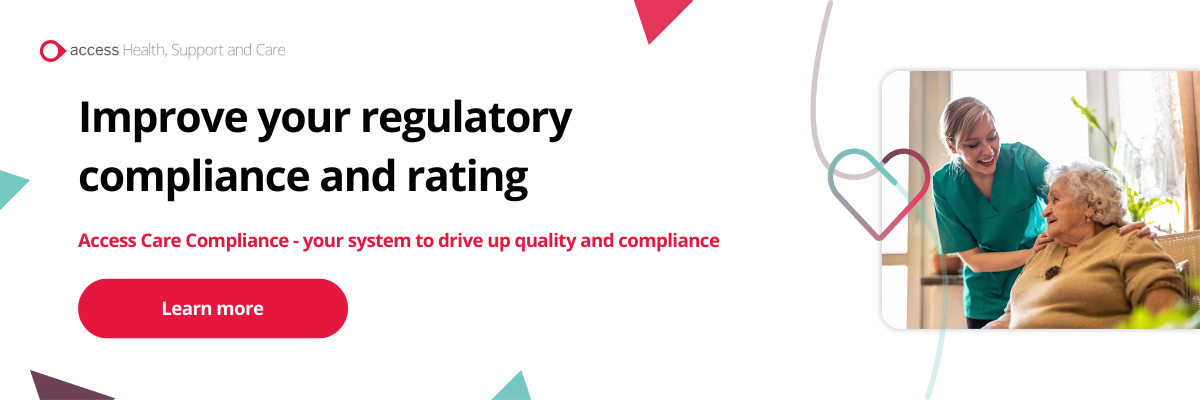CQC Quality Statements
CQC Quality Statements were introduced in 2023, by the Care Quality Commission (CQC) as part of a major update to its inspection framework. The Quality Statements replace the Key Lines of Enquiry (KLOEs). These quality statements play a crucial role in assessing and safeguarding the quality of care provided by health and social care services across the UK.
The CQC quality statements have been designed to address the core aspects of care delivery, incorporating a wide range of services and settings. These statements are crucial elements in the CQC inspection framework, serving as standards which providers are evaluated against. They also align with the CQC’s commitment to promoting transparency, accountability and continuous improvement within the health and social care sector.
We at The Access Group have been helping care services become more compliant for over 30 years. In this article, you’ll learn more about the various domains the CQC 34 quality statements cover, how they reflect the comprehensive nature of the assessment process and the structure, content and examples of these quality statements. By the end of this, we hope that you will understand their significance.
What are the New CQC Quality Statements?
The CQC quality statements are the obligations that providers, commissioners and system leaders need to live up to. Also known as ‘We Statements,’ they demonstrate what’s required to deliver high-quality, person-centred care. The new CQC quality statements have been organised to address the CQC’s five key questions that form the foundation of the inspection framework. The five key questions are:
- Is the service safe? – This includes the learning culture, safe systems, pathways and transitions, safeguarding, involving people to manage risks, safe environments, safe and effective staffing, infection prevention and control and medicines optimisations.
- Is the service effective? – This includes assessing needs, delivering evidence-based care and treatment, how staff, teams and services work together, supporting people to live healthier lives, monitoring and improving outcomes and consent to care and treatment.
- Is the service caring? – This includes kindness, compassion and dignity, treating people as individuals, independence, choice and control, responding to people’s immediate needs and workforce well-being enablement.
- Is the service responsive to people’s needs? – This includes person-centred care, care provision, integration and continuity, providing information, listening to and involving people, equity in access, experiences and outcomes, and planning for the future.
- Is the service well-led? – This includes shared direction and culture, capable, compassionate and inclusive leaders, freedom to speak up, workforce equality, diversity and inclusion, governance, management and sustainability, partnerships and communities, learning, improvement and innovation and environmental sustainability.

How Quality Statements Align With The 5 Standards
Each of the questions above is now supported by a set of specific quality statements that guide the inspector through the process. The statements are not only focused on the end results, but they also emphasise the processes and practices that contribute to high-quality care. They provide a framework for care providers to continually evaluate and improve their services.
To answer the five key questions, CQC will assess services against the new topic areas and quality statements collecting evidence in a range of areas including:
- People’s experience of health and care services
- Feedback from staff and leaders
- Feedback from partners
- Observation
- Processes
- Outcomes
The main thing care services will need to keep in mind is that there may be gaps between what they currently do and what they’ll need to adapt in their existing quality assurance/audits, systems of work, etc. to ensure they are compliant with the quality statements. For example:
- Learning culture (in safety)
- Safe systems, pathways and transitions
- Environmental sustainability
- Workforce well-being and enablement
These are all quality statements that have a new approach or a different emphasis that CQC will explore once they start rolling their cycle of new assessments.
What Does All of this Mean?
- People will receive care, treatment and support that’s evidence-based and in line with good practice standards.
- The care provider’s systems will ensure that their employees are always up-to-date with evidence-based good practice, required standards and national legislation.
- People will be told about current good practice that are relevant to their care and will be involved in how it’s reflected in their care plan.
- The nutrition and hydration needs of people will be met in line with current guidance.
- Employees and their leaders are encouraged to learn about new and advanced methods. Evidence shows that this may improve the way their service delivers care.
CQC Quality Statements Examples
The new CQC quality statements contain a variety of domains within each key question. Here are some examples for you to explore:
Is the Service Safe?
Example Quality Statement – ‘’People are protected from abuse and avoidable harm.’’
Evidence Categories – Staffing levels, training, risk assessments and safeguarding policies.
Is the Service Effective?
Example Quality Statement – ‘’People’s care, treatment and support achieve good outcomes, promote a good quality of life, and are based on the best available evidence.’’
Evidence Categories – Treatment plans, adherence to clinical guidelines and service user outcomes.
Is the Service Caring?
Example Quality Statement – ‘’Staff treat people with kindness, dignity, respect and compassion.’’
Evidence Categories – Service User feedback, staff-service user interactions and person-centred care.
Is the Service Responsive to People’s Needs?
Example Quality Statement – ‘’Services are planned and delivered to meet the needs of different service user groups, ensuring flexibility and responsiveness.’’
Evidence Categories – Service planning, accessibility and service user involvement in decision-making.
Is the Service Well-Led?
Example Quality Statement – ‘’Leaders create a positive culture that fosters high-quality, person-centred care.’’
Evidence Categories – Leadership structures, governance processes and staff engagement.

CQC Single Assessment Framework Quality Statements
The CQC quality statements have been precisely incorporated into the single assessment framework, providing a unified approach to evaluating and monitoring health and social care services. The integration ensures that the assessment process is coherent and consistent, allowing inspectors to gain a comprehensive understanding of the quality of a service.
‘’I’’ and ‘’We’’ Statements CQC
A notable addition to the CQC quality statements is the introduction of the new ‘’I’’ and ‘’We’’ statements. These statements accentuate the individual and collective responsibilities of care providers when it comes to delivering quality care. The ‘’I’’ statements focus on the personal commitment and accountability of individual staff members, while the ‘’We’’ statements highlight the collaborative efforts of the entire team.
‘’I’’ Statements CQC:
These play a key role in the People’s Experience evidence category that helps the CQC gather, listen to and act on experiences people have had. Their experience care will impact their decision-making and lead them to take appropriate action. Tools and techniques, like interviews, focus groups and case tracking, are being developed to help the CQC gather the right evidence for their assessments.
Example – ‘’I take responsibility for my actions and strive to continuously improve the quality of care I provide.’’
Evidence Categories – Personal development plans and reflective practice.
‘’We’’ Statements CQC:
These are written from a provider’s perspective to help them understand what the CQC expect from them. They expand upon previous work that has been developed with Think Local Act Personal (TLAP), Coalition for Collaborative Care and National Voices. The CQC wanted to maintain this attitude when developing its assessment framework.
Example – ‘’ We work together to create a supportive and inclusive environment that enhances the overall well-being of our service users.’’
Evidence Categories – Teamwork, staff surveys and communication within the team.
CQC Quality Statements and Evidence Categories
To verify compliance with the new CQC quality statements, health and social care service providers are required to present evidence across various categories. These evidence categories serve as indicators that reflect the implementation of practices aligned with each quality statement. This evidence-driven approach adds a new element of depth to the assessment process, promoting a rounded understanding of service quality. Just so you are aware, the six new evidence categories are:
- People’s experience.
- Feedback from staff and leaders.
- Feedback from partners.
- Observation (this category won’t be used in these assessments as it does not apply to the specific context of a local authority).
- Outcomes (this category won’t be used in the initial formal assessments).
The CQC want to be clearer to their providers and the public about how they use the information they have on a care service or local area. So, for each quality statement, they will state which evidence they will always have to collect and evaluate. The type of service will determine what they will require.

CQC New Quality Statements – Stay Updated!
To conclude, the new CQC quality statements that were introduced in 2023 represent a significant advancement in health and social care service assessment across the UK. These statements, which can be found within the CQC inspection framework, provide a thorough mechanism for evaluating and ensuring the delivery of safe, effective, caring, responsive and well-led care.
The incorporation of ‘’I’’ and ‘’WE’’ statements further highlights the responsibilities of health and social care providers, especially when it comes to achieving and maintaining high-quality care standards. The evidence-based approach, coupled with the integration of the single assessment framework, makes these quality statements the cornerstone in promoting constant development and accountability within the health and social care sector.
After working with thousands of care businesses across the country for over 30 years, we at Access understand that all these changes can be overwhelming and confusing, especially with the amount of information being released and the bustle of the sector. Fortunately, we are here to help. The Access Group has a selection of very thorough content, including our up-to-date CQC inspection checklist and an informative CQC New Methodology Guide that you can download and read at your own leisure.
You can also take advantage of our award-winning software to ensure your care service is compliant. We recommend using Access Care Compliance. This platform has been created to help your audits become more systematic and effective while managing, tracking and improving quality, which will make services more compliant as a result. You can also carry out mock inspections aligned with the CQC’s new inspection framework. Speak to one of our experts to learn more or book your care compliance demo.


